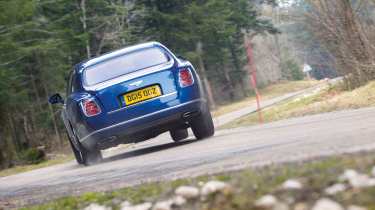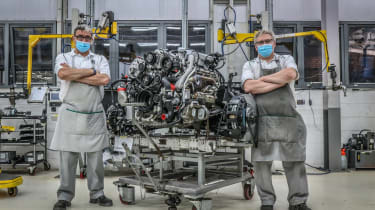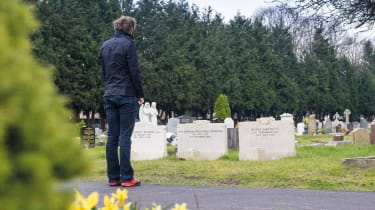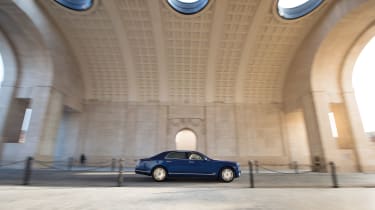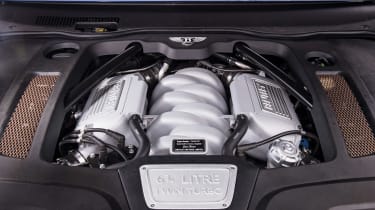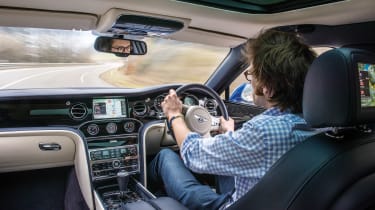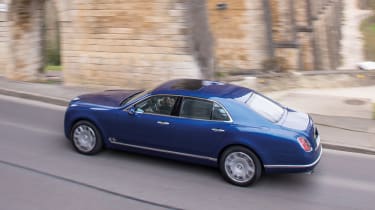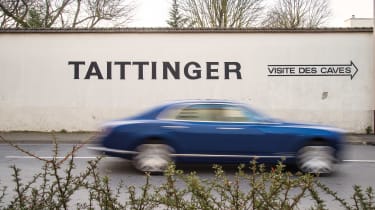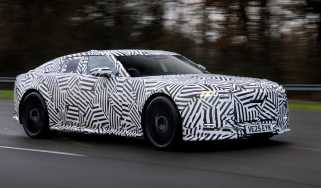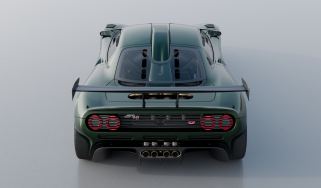Bentley’s 6.75-litre V8 engine is no more: we pay homage with a classic road trip
After 61 years of service, the end has come for Bentley’s 6.75-litre V8. To mark the occasion, we take one on a road trip from London to Geneva
Production of Bentley’s 6.75-litre V8 has come to a close, following six whole decades of use across multiple generations of the marque’s offerings. The very last unit was dropped into the final of 30 Mulsanne 6.75 Editions, with the now-ubiquitous twin-turbocharged 6-litre W12, 4-litre twin-turbocharged V8 and the hybrid V6 powertrain of the Bentayga taking its place.
A total of 36,000 L-series units were produced over its 61-year production run, and since its first use in the 1959 Bentley S2, it has come quite some way – output stood at just 180bhp in its first iteration, but was lifted to over 500bhp and a monumental 811lb ft of torque at its peak.
> Bentley Mulsanne 6.75 Edition launched to mark end of production
Bentley’s member of the board for manufacturing, Peter Bosch, said: ‘I am extremely proud of the generations of skilled craftspeople that have meticulously assembled every one of these engines by hand over the years. That this engine stood the test of time for so long is testament to the ingenious engineers who kept making the engine ever more powerful, refined and reliable.’
To pay homage to the longest-serving V8 design in continuous production, we step back to 2016, when we drove from London to Geneva in a Bentley Mulsanne. Powered by the famous 6.75-litre unit, Henry Catchpole embarked on the journey to find out if it was possible to cover the distance in the same time it took Bentley to build one.
London to Geneva in the Bentley Mulsanne Speed
'How long does it take to build?’ is the sort of easy question asked on a factory tour by someone with a thirst for knowledge but without a really deep understanding of what he is looking at. Someone like me. I’m standing in awe next to the Bentley Mulsanne’s magnificent six-and-three-quarter-litre (please, never ‘six-point-seven-five’) twin-turbocharged V8, which has been around in one form or another since 1959. This formidable longevity makes it the oldest engine still in production. The answer to the question is ten-and-a-half hours (by hand), which sets my brain cells pondering another question: how far could you drive in that time?
After a bit of keyboard work back in the office the following day, I discover that one of the answers, conveniently, is ‘from London to Geneva’. Even more conveniently, as I’m sure you’re aware, there is a motor show in Geneva every year, and at the 2016 extravaganza, Bentley would unveil a new Mulsanne. Perfect, except that sitting on the motorway/autoroute for ten hours wouldn’t really make much of an adventure. However, if you start the clock at Calais, avoid the toll roads and throw in a few appropriate diversions, you get a much more compelling way of passing ten-and-a-half hours behind the wheel.
> 2020 Bentley Flying Spur review
So, the scene is set. A Mulsanne Speed arrives at the office in late February, and unreasonably early on a Saturday morning I collect photographer Aston Parrott and we head for the Eurotunnel. But we don’t head straight there.
I’ve always wanted to do some sort of race in a Bentley and the entire reason for this is my long-standing fascination with Woolf Barnato, who raced and famously beat the night-express train ‘Le Train Bleu’ that ran between the Côte d’Azur and Calais. All the Bentley Boys were intriguing characters, but Barnato perhaps stands a little taller amongst them. His perfect record of three wins from three entries at Le Mans (1927-29) remains unmatched and WO Bentley said he was ‘the best driver we ever had and, I consider, the best British driver of his day. One who never made a mistake and always obeyed orders.’ I also love the idea of the glorious polymath and Barnato was undoubtedly one of those. We see it so rarely in this age of increasing specialisation, and perhaps back in the time of CB Fry it was easier, but nonetheless Barnato’s palmarès is impressive: amateur boxer, wicket-keeper for Surrey, keen shot, motorboat racer, horse breeder, captain in the Royal Artillery and wing commander in the RAF.
He died on 27 July 1948 at the age of just 52, succumbing to a blood clot after an operation for cancer, and he is buried at St Jude’s United Church in Englefield Green, Surrey. Standing on the corner of plot 25, there are three gravestones: Woolf, his daughter Diana (herself an extraordinary aviator) and her husband Wing Commander Derek Walker, who died flying a Mustang in bad weather in 1945. I’ve never been here before and it might seem like a sombre way to start a journey, but the few minutes of quiet reflection feel like the right way to begin.
A couple of hours later we are entering the belly of a Eurotunnel train, having opted for the wider option with the coaches. At over seven feet wide including wing mirrors, this is not a car to trifle with width restrictions. Once our tyres hit French tarmac, I start the stopwatch and (hypothetically) at the same time in Crewe someone attacks the first job on the engine-build list, which is to begin assembling internal parts such as the pistons and rocker shafts.
Studiously avoiding signs for the A26, the Mulsanne settles into an unstressed cruise like a retired general lowering himself and a broadsheet into the most softly sprung armchair in the club. ‘Settle down chaps, we’re in this for the long haul,’ it seems to be saying. The bottomless torque, all 811lb ft of it at 1750rpm, is palpable but also defining – I’m not sure I’ve ever driven a more languorous car. As we lope along, the rev counter is reading barely 1500rpm and even a breezy overtake doesn’t require more than 3000rpm as we sweep past a line of lorries. At the moment, the idea of reaching the histrionics of the red line all the way up at a stratospheric 4500rpm seems almost wrong. It would be like seeing the Queen running.
> Bentley Mulsanne 6.75 Edition launched to mark end of production
Every time I travel through northern France I can’t help but look at the vast, flat arable landscape and picture it chewed up by the First World War. Names such as Arras, Somme and Cambrai appear on signs, and countless small cemeteries with rows of white crosses stand lonely in fields as reminders. Barnato served as a lieutenant (eventually rising to captain) in the Royal Horse Artillery and Royal Field Artillery during the war. It’s quite hard to find records of where he fought, but his first posting seems to have been to Ypres in 1915. As it’s not much of a diversion to duck across the border into Belgium, that’s where we head first.
Ypres, or ‘Wipers’ as the British troops used to call it, is actually the French name for the town. All the signposts say the Dutch name, Ieper, which is mildly confusing if you’re not expecting it. The Menin Gate there is dedicated to the 56,000 British and Commonwealth soldiers who died in the Ypres Salient between 1914 and 15 August 1917 but who have no known grave. We drive quietly beneath the barrel-vaulted ceiling inscribed with names before parking up in a side street and wandering back. About halfway along the northern wall I find the inscriptions of those in the Royal Horse and Royal Field Artillery and spend a minute or two reading all of them.
In the ten minutes it takes to wriggle our way out of the streets of Ypres, the crankshaft will have gone in back at Crewe and it feels like we need to cover some serious ground to keep pace with the engine build. The next stop is Reims, some three hours away, by which point the sump will be on and the engine will be emerging from the balancer ready for its cylinder heads. We bisect Roubaix and Lille remarkably easily and emerge onto much more rural roads. The Mulsanne surges wonderfully under every acceleration, nose rising slightly every time we exit a town or village. As we get closer to Reims there are some magnificently long, straight stretches of road. Sometimes these straights are bordered by a corridor of tall trees, which inevitably increases the sensation of speed. Other times you feel as though you’re hardly moving as the asphalt spears through vast open fields all the way to a distant horizon, like some sort of exercise in perspective. Frequently you’ll reach the horizon to discover that there is only a slight kink into another arrow-straight bisection of the world. It doesn’t take the wildest imagination to draw a link between these straights and the one that this magnificent beast of a Bentley is named after.
I’ve always been astounded at the thought of manhandling one of the mighty 4½ Litre or Speed Six Bentleys around Brooklands circuit. And the 2610kg Mulsanne feels like the true descendent of those huge cars. Of course, even threading the Mulsanne Speed through a tight roundabout at pace requires none of the physicality the vintage cars would have needed. It is a paragon of precision by comparison. But something about the way you need to manage the mass, letting it settle as the body rolls, makes the Mulsanne feel very different to any of the Continentals, even the Flying Spur. Switching to Sport mode, the steering quickens noticeably and the damping firms up (introducing a little shudder through the body and wheels over bumps), but the underlying weightiness remains. ‘Jink’, ‘dart’ and ‘flit’ are not words you will find in any road-tests of a Mulsanne.
What you get as dynamic compensation for the weight is the engine – the undeniably dominant heart of this car. Back in 1954, Bentley’s 4.9-litre straight-six was at full stretch and Bentley’s engine engineer, Jack Phillips, was told to design something new with 50 per cent more power and torque. Five years later a new 6.23-litre naturally aspirated V8 with an aluminium alloy block and heads, hydraulic tappets, a compression ratio of 8:1, twin carburettors and an automatic choke was brought to production. It was shown in the new S2 and shared with the Rolls-Royce Silver Cloud II. There was also a higher-performance version of the S2, called the Continental S2, which I suppose is really the great-grandfather of today’s Mulsanne Speed.
By 1970 the displacement had already reached today’s considerable capacity, but it wasn’t until the Mulsanne Turbo was unveiled at the 1982 Geneva motor show that the V8 received its first forced induction. This saw a jump in power of at least 50 per cent to 300bhp, and then, as it homed in on its 30th birthday, this grew to 328bhp as fuel injection was added. By the time it reached over 400bhp, under the bonnet of the Turbo R and Continental T in the late 1990s, it was due to be phased out.
But that wasn’t the end, because in 2002 the single turbocharger was replaced with two smaller turbochargers and the engine found a home under the bonnet of the Arnage T. Today, well into its sixth decade in production, the V8 has cylinder deactivation, meaning that although it produces around three times the power and torque of the original, its tailpipe emissions are down by 99 per cent. What’s more, it’s been said that this incredible engine isn’t even close to its limits in terms of bearing and block strength.
Perched on a hill, Laon’s impressive Gothic cathedral is visible for miles, lit up like a crowning jewel on a pile of sparkling lights. Then it’s on down more endlessly straight roads to Reims, where we’re stopping for the night. Yes, stopping. There’s a clocking-off time in Crewe and while they’re not building, we’re not driving. Sorry.
Early the following morning we ponder going to the circuit, but on this occasion it seems more appropriate to take a couple of photos in front of the wonderful walls of the champagne houses. Lanson, Taittinger, Pommery, Veuve Clicquot Ponsardin: all are based in Reims and it’s reported that Barnato was fond of a drop. It was said that he could drink two bottles of the bubbly stuff with no visible effect. Given that we’ve been carting a small built-in fridge and some Bentley champagne flutes around with us between the rear seats, perhaps I should have tried the two-bottle trick last night myself, in homage to Woolf. But Barnato was built like a heavyweight boxer (his nickname was therefore ‘Babe’) and I am not, so the expenses department and my liver are both spared.
The clock restarts with the engine builders back in Cheshire thinking about fitting the alternator. We set a course for Chaumont (engine undergoing hot test), Langres (steering rack being fitted to the front subframe) and eventually Besançon. As you would expect, the Mulsanne is a very lovely place to spend time. Listening to my favoured Desert Island Discs podcast through the Naim stereo, it’s almost as though Kirsty Young and her guest, the adventurer Ben Saunders, are in the car with us, chatting away on the back seats. As Saunders describes following in Shackleton and Scott’s footsteps to the South Pole, I instinctively turn up my heated seat. Outside, the white peaks of the Alps are almost coming into view but there isn’t as much snow as I was expecting for this time of year. Nonetheless, the Speed is wearing Pirelli Sottozero winter tyres just in case.
Scrolling through the various numbers in the trip computer, I notice that we are averaging 45mph, the exact figure that Barnato averaged when he raced Le Train Bleu across France 86 years ago. The train went from Cannes to Calais, and although a Rover Light Six had already beaten the train over this route, Barnato decided to raise the stakes, claiming that he could reach London before the train reached Calais. Starting from the bar of the Carlton Hotel in Cannes just before 6pm on 13 March 1930, Barnato and his relief driver Dale Bourn battled rain, fog and a puncture on their way northwards. In the middle of the night they also lost time searching for a pre-arranged fuelling rendezvous near Auxerre, but at 3.20pm the following day, the Bentley 6½ Litre Speed Six reached Bourn’s club in St James. Four minutes later, the train arrived at Calais. Barnato had won his £100 bet.
With Lausanne practically in sight, it’s obvious that we are going to fall just short of our ten-and-a-half-hour goal. Back in Crewe, the wiring loom will be being hooked up to the gearbox and the engine will be being mounted onto the subframes – the final jobs. Perhaps I should lie for the sake of the story and say that we made it with seconds to spare… Charging headlong down the shores of the sparkling Lake Geneva, we hit 175mph. The Mulsanne Speed is pulling, ironically, like a big blue train and we show flagrant disregard for all draconian Swiss speed enforcement.
‘Send the bill to Brooklands!’ I yell as the flash of a camera illuminates the tarmac we have just thundered across. ‘Mark it for the attention of Sir Henry – Birkin or Segrave, it matters not!’
The outskirts of Geneva are ahead of us and with every second the tension is rising, so I crank up the massage seats. Any traffic is potentially disastrous to the cause and my navigator, Aston ‘Polly’ Parrott, is working hard too, slaving over a knurled aluminium dial. At the last moment he taps the touchscreen and re-routes us around the district of Versoix. The town might have a lovely chocolate festival, but its sticky centre is not what we need right now. Threading our way round the congestion we charge onwards, riding a tsunami of torque towards not only our destination, but also tea and crumpets and victory… In reality, as the last nut is torqued in Crewe, we will be within touching distance of Geneva, yet undeniably just short. Perhaps we shouldn’t have taken that detour via Ypres? But I think Barnato would have approved.
With the race effectively lost, I decide to deviate from the route slightly and head down a more interesting piece of road. There is a lonely fromagerie, and outside is a huge wheel of cheese with a Pacman-esque triangle missing. We turn right just alongside it. The road is rough but the Mulsanne seems not to notice. As we snake between pine trees, Parrott suggests that a cornering shot might look quite fun. I like a challenge.
Having selected a medium-speed right-hander that’s comfortingly slightly uphill and Aston having wisely situated himself in a position to capture the scene from the rear, I turn off the ESP and take a run up. Using the small paddles to hold the gears, it’s almost a surprise to find that the huge engine rips so merrily up to its red line when asked. It seems Her Majesty does own a pair of running spikes.
When you’re relying on an ECU to do the changes, you barely notice them. So rarely does the flow seem to be interrupted that you might assume it was an old three-speed auto rather than a modern ZF eight-speeder. However, when you’re summoning the ratio swaps yourself, you do need to allow a little time for the transmission to gird its loins on downchanges. So, up to fourth, brake, request third, let the car settle, turn-in with enthusiasm, and reapply the throttle. Such is the length of the wheelbase (10ft 8in) that you feel the rear wheels begin to swing round on the same sort of timescale as tectonic plates work to, with their own continental style of drift. It’s almost lazy and you feel like you have plenty of time to apply any corrective lock, but you can never quite shake the sense of trepidation that comes with over two-and-a-half tons moving around.
Two days later I watch the new Mulsanne being unveiled on a glitzy motor-show stand in the Palexpo convention centre in Geneva. I’m not sure about the new grille if I’m honest, but I am very glad that behind it is the same venerable six-and-three-quarter-litre V8. It is motoring royalty (it has certainly propelled royalty) and I can’t think of another engine that so completely defines and dominates the character of a car. Its disdain for revs but bountiful torque is, in its own way, as glorious and emblematic as an Italian V8 yowling to 9000rpm with a flat-plane crank. It produces sensations that have to be experienced to be believed and, as it closes in on its diamond jubilee, I hope it is around for many years to come.

